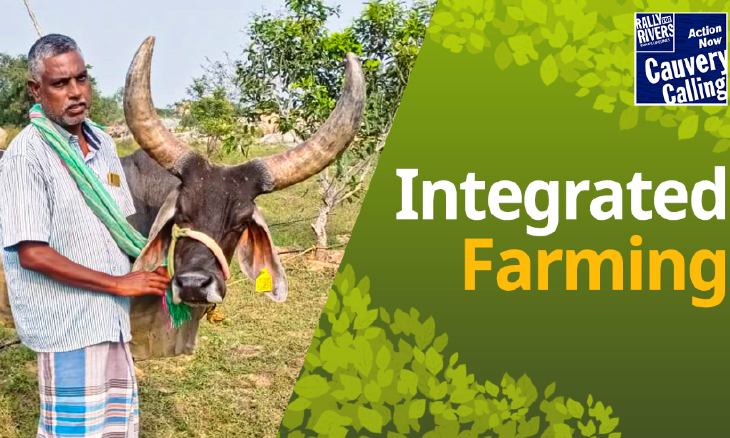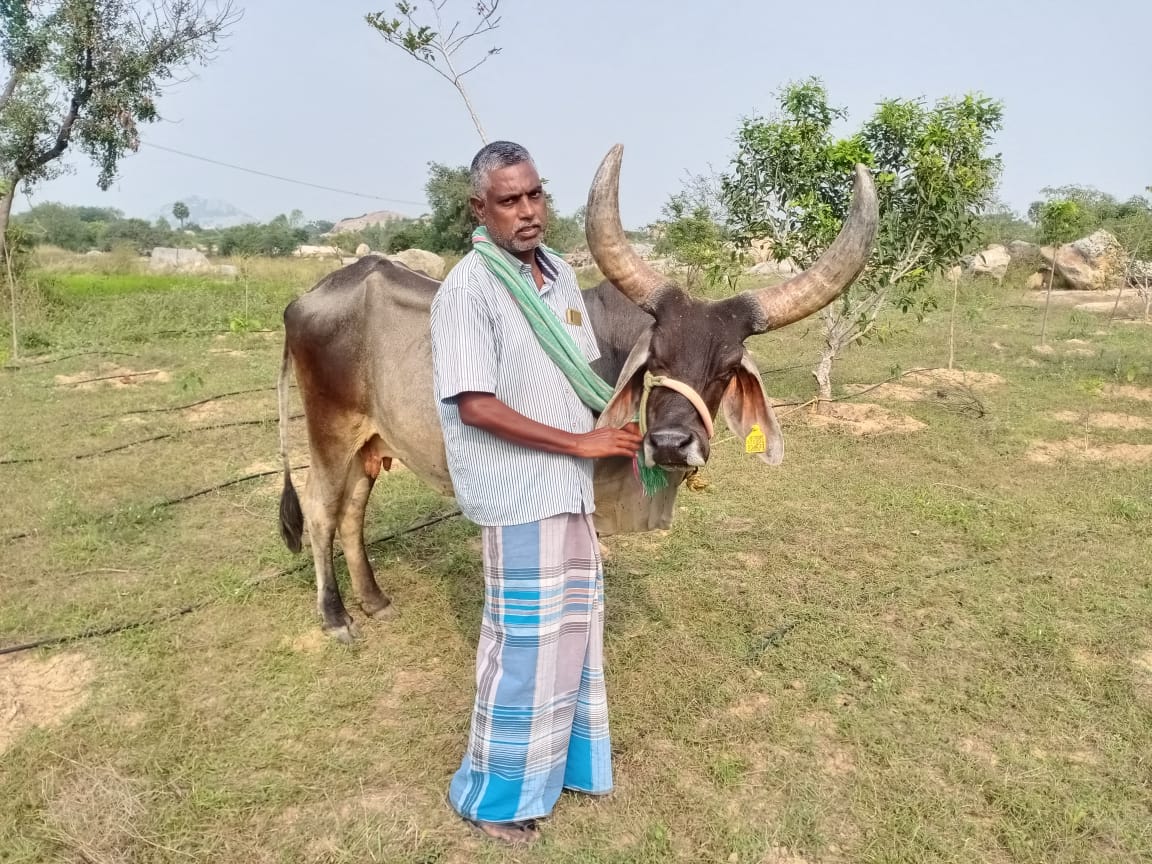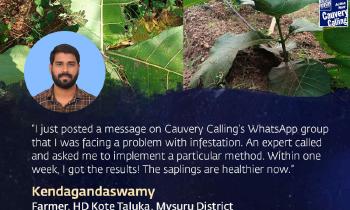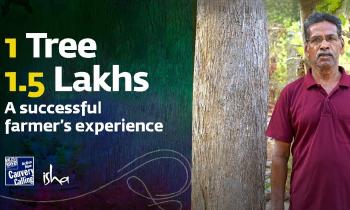Tamil Nadu Farmer Develops Lucrative Integrated Farming Model
This is an inspiring story of success of integrated farming in a village in Tamil Nadu. Murugavel, a farmer, has set up an integrated farm on his land in Kandachipuram village in Villupuram district of TN. He has also taken up fish farming on his land and earns a profit of Rs 1.5 lakh per year from two farm ponds.

Murugavel’s journey of growth began on three acres of native land and three acres of leased land. He has grown 1,000 trees on three acres of land and between these trees he has grown 400 guava trees in one part of the land. In the other part, he has two farm ponds. On the remaining farmland, he has many country cows.
Integrated farming: The beginning
Speaking about how it all began, Murugavel said: “My land was so barren that even grass would not grow. It has now been transformed into an integrated farm and I’m leading a contented life.”
“Two years ago, when I started tree-based farming, people made fun of me. Today the same people seek my advice. This makes me feel proud!” said the farmer, who took a team of Cauvery Calling volunteers to his beautiful grove.
The same evening amidst the cool breeze of the teak trees and the natural setting that was soothing for the eye, with the fishes whizzing past in the pond and the sunlight streaming through the tree leaves, everything on the farm fascinated the visitors. Sitting in Murugavel’s beautiful farm in Kandachipuram village, they listened to the farmer’s story.
"My wife was diagnosed with brain cancer. So, I left my spinning business seeking fresh air and natural food. I left for my hometown to save my wife's life. I wanted to do natural farming here. But this place has water scarcity. So, I planted drought-tolerant trees. To water these trees, I set up farm ponds and started storing rainwater during the monsoon. The trees began to thrive, and I noticed changes in the nature of the soil due to the shedding of leaves and the use of organic matter,” he said.
Generating income
Elaborating on how he planned to make his farm productive, Murugavel said: “I thought, the trees are my investment for the future, but shouldn't I also be looking at getting revenue now? Then I decided to raise fishes in my farm ponds. The result: today I earn Rs 1.5 lakh through fish farming. I also raise country cows. Apart from this, I have leased three more acres of land. I cultivate a variety of agricultural crops on these three acres that is irrigated by the water leaking from my farm pond. So, it is a process through which I keep getting constant income."
People in the region share details about not being able to farm because of drought. However, Murugavel was able to think of alternatives for his farm. He planted trees and built an ecosystem to support the growth of his trees. He started collecting rainwater, raising fish and is now cultivating agricultural crops. All these activities are generating good money for the farmer. He is also able to live a contented life in a natural setting.

Techniques the farmer implemented in his farm
Murugavel speaks about the methods he adopted in his farm.
Introduced trees that changed the soil: “Three years back, I planted trees like teak, mahogany, ‘Poovarasu’, sandalwood, Malabar kino, jamun, red sanders and amla at intervals of 10 feet on three acres of land. These trees are growing well. I will begin to benefit from them in a few more years. I set up a farm pond to meet the water needs in my farm. I collected and stored rainwater in it and used it for trees in summer. The trees are growing well and they provide a shady environment. This has changed the nature of the soil.”
Fish farming: “I developed two farm ponds measuring 20×22 meters and 30×40 meters. I dug a pit with a depth of eight feet. In this pit, rainwater stagnated through the rainy season. During this time, I bought a wide-variety of baby fish like katla, rohu, mrigal and pul kendai. I started growing 1,000 baby fish in one pond and 2,000 baby fish in the other pond. Among these, 90 percent will grow into large fish.
The baby fish are not fed any store-bought food. I mainly feed them cow dung and jeevamrutha (a natural liquid fertilizer). This increases microorganisms in the pond. Cow dung is also an important source of food for the growth of fish. After consuming this, the fish will grow to harvest size in about 6 months. In addition to this, I also set up two tanks in rocky places. I have grown Azolla in it to feed the fish. Azolla does not cost much to grow, it involves only my labor cost. Thus, my expenses are reduced.
I have raised 1,000 to 2,000 baby fish during the last two years. Of this, leaving out wastage, I got a total of 1,250 kg of fish. I sold a kilo of fish in the price range of Rs.150 to 200. I got around Rs 1,87,500 from the sale. This includes a sum of Rs 37,500 which was the cost of buying baby fish, labor cost for the people fishing for me and other expenses related to sale. The remaining Rs 1,50,000 was my profit!
This is an high-level estimate of what I have done in the last two years. I am raising Viral baby fish this year. Viral fish sells for Rs 350 to 400 a kg. Other fishes are more profitable if they are reared in densely populated areas.
I expect a total profit of Rs 3 lakh from these two farms alone this time. I did not spend much on these farms. I dug this farm pond to get water for trees. Today these farms give me additional income.”
Intercropping between trees: “I have planted guava in one part of the land between the trees. It has been 10 months since planting these trees. The fruiting season has begun and I expect a better return from these trees as well. It is only after the trees have been planted that the soil becomes suitable for other crops. So, I started inter-cropping and generating income from it.”
Natural, organic farming methods: “I cultivate agricultural crops on three acres using water from the farm ponds. The farming is completely natural. Following this method, I cultivate crops like black gram, groundnut and sesame. All these crops are grown naturally. I also grow traditional type of paddy. After my personal use, I sell the remaining to my friends, relatives etc. as unpolished rice.
Today my wife’s health has improved as she has been having natural food and breathing and living in a natural environment. Even when doctors gave up on my wife’s health, these trees and nature have saved her life. Trees provide income and create conditions to breathe fresh air and live peacefully.”
This model farm, which is self-sufficient, is a good example of how trees provide opportunities for sustainable and steady income.












